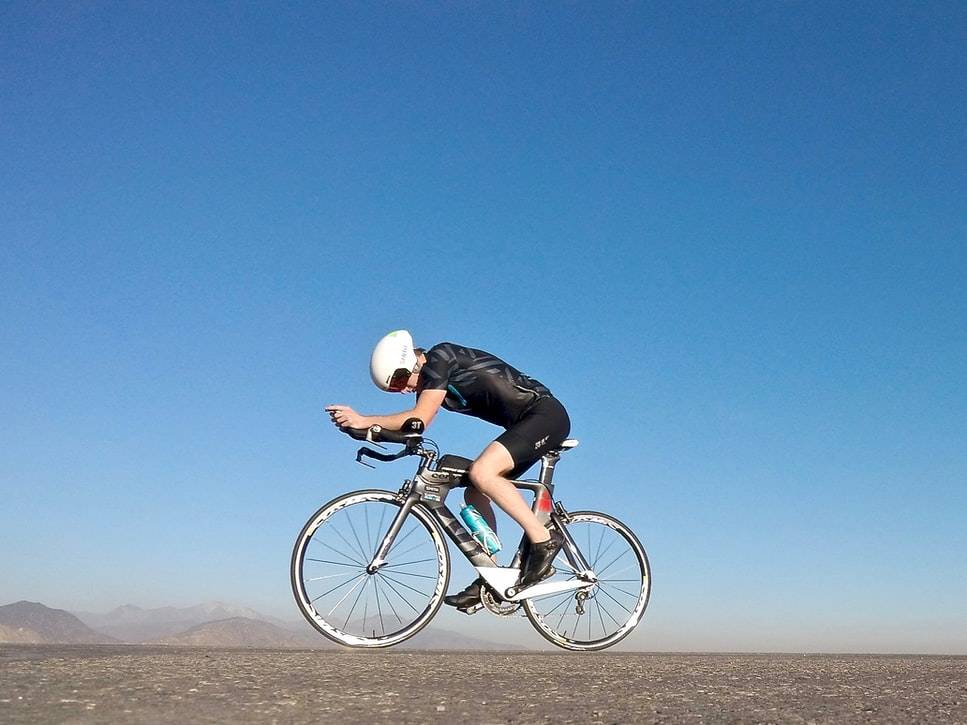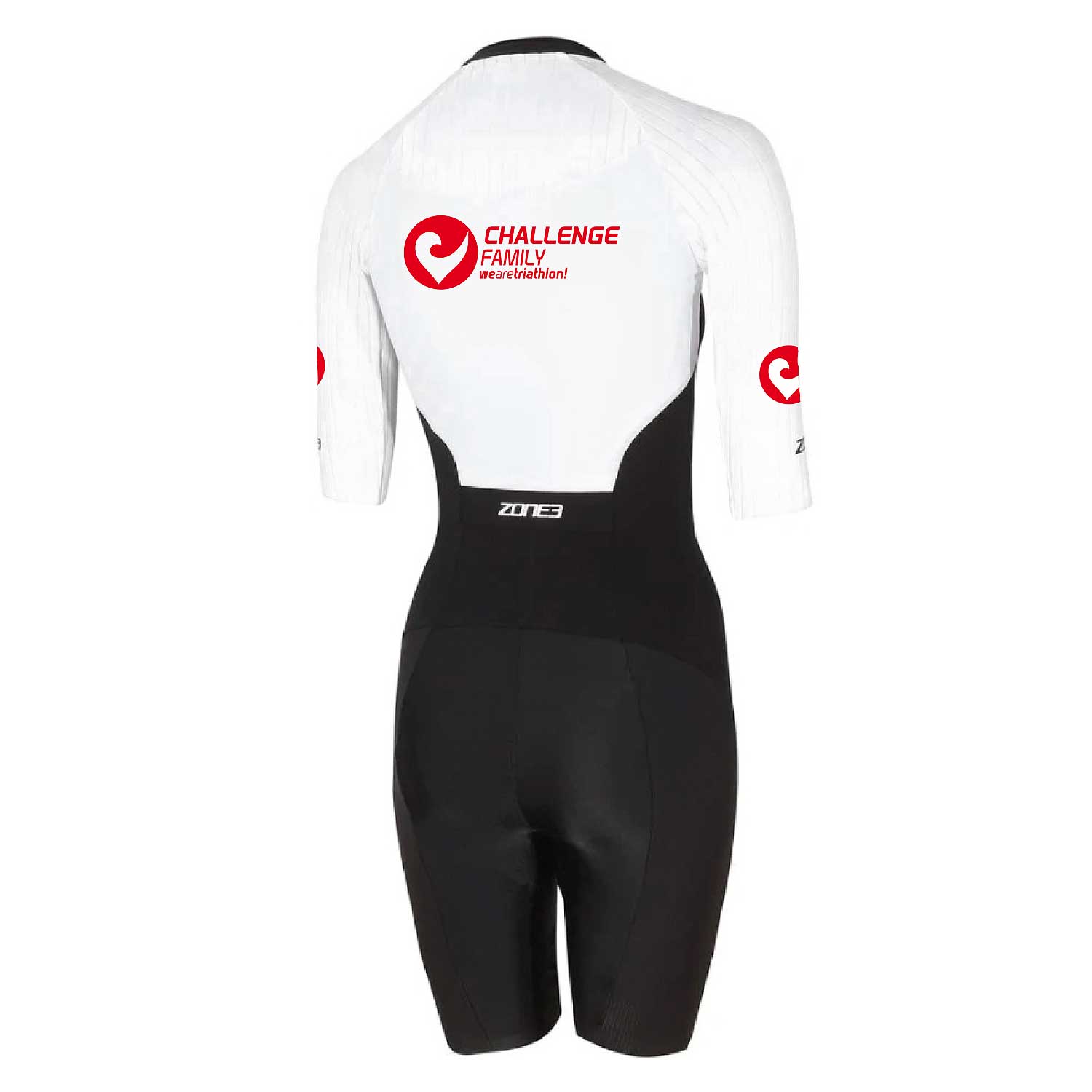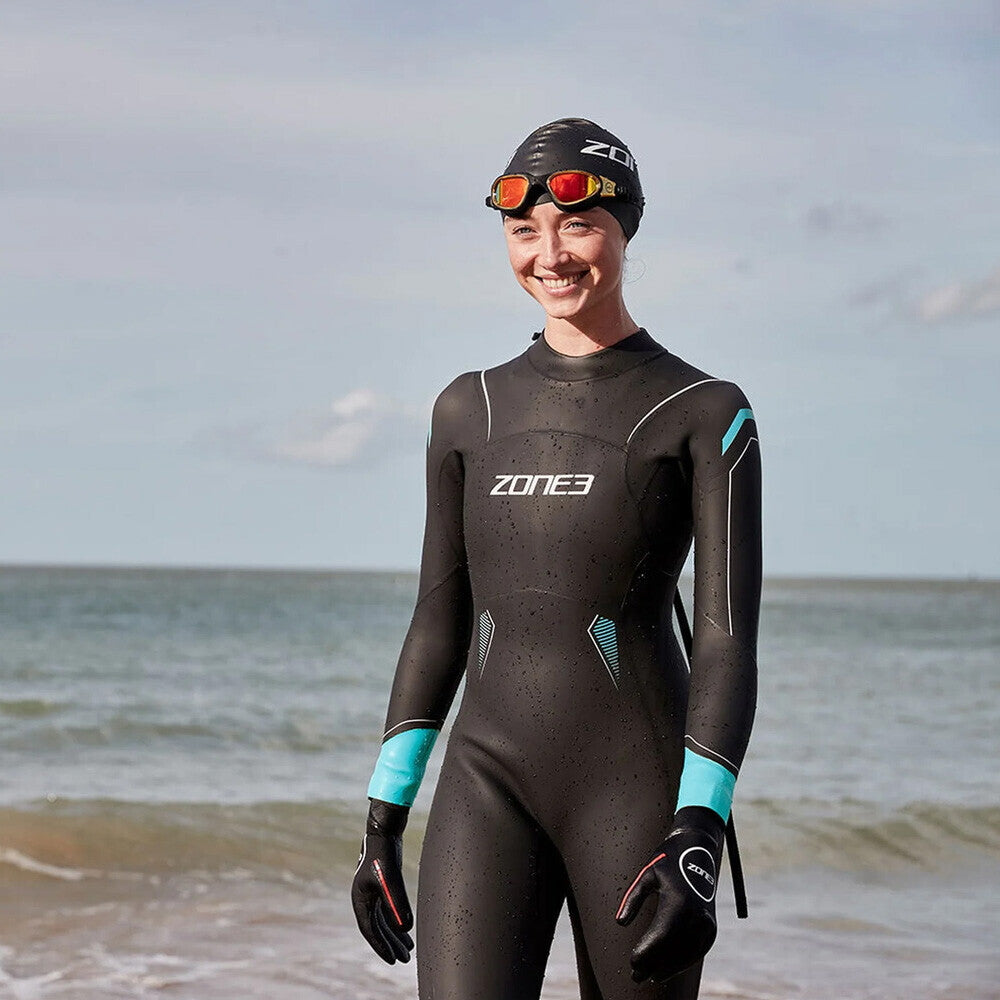„…es reist sich besser mit leichtem Gepäck…“, trällert uns die Band Silbermond gefühlt alle fünf Minuten aus dem Radio entgegen. Für Triathlon Räder ist das nicht die ganze Wahrheit, denn auf flachen Strecken sind aerodynamische Vorteile nützlicher als geringes Gewicht. Nur finden die interessantesten Triathlons ganz selten auf flachen Strecken statt. Wir sagen dir deshalb, welche Maßnahmen sinnvoll sind.
Aerodynamik vs. Gewicht
Wann lohnt es sich also auf das Gewicht, statt auf die Aerodynamik zu achten? Wenn es bergauf geht auf jeden Fall.
Auf vielen der schönsten, spektakulärsten und am meisten fordernden Strecken sind jede Menge Höhenmeter zu überwinden. Man denke dabei an Rennen wie Immenstadt, Norseman, Lanzarote, Alp d`Huez, Silverman, Embrunman, … um nur einige zu nennen.
Zwar kann ein Triathlonrad dort immer noch Sinn ergeben, aber hier sollte man das Gewicht schon im Auge behalten. Noch deutlicher wird das auf Kurzstrecken wie in Kitzbühel oder am Schliersee. Hier mit dem Aerorad und Scheibenrad zu starten, ist wie ein 100-Meter-Sprint mit Moon Boots.
Im professionellen Bereich sagt man, dass ab einer Steigung von 7 – 8 % der Vorteil eines geringeren Gewichts wertvoller ist (also mehr Zeitersparnis bringt), als eine bessere Aerodynamik, was aufgrund der geringeren Geschwindigkeit logisch erscheint. Im Amateur-Bereich dürfte das sogar schon bei 5 -6% Steigung der Fall sein. Und auch, wenn es auf den meisten Kursen auch irgendwann wieder bergab geht, so lässt sich die am Berg verlorene Zeit nicht wieder vollständig gut machen.
Bergauf Passagen sind aber nicht der einzige sinnvolle Bereich für geringes Gewicht. Speziell bei Laufrädern ist geringes Gewicht sehr deutlich in der Beschleunigung spürbar. Auf Strecken mit vielen engen Kurven, wo häufiges Abbremsen und Antreten notwendig ist, sind leichte Räder durch nichts zu ersetzen. Wo lässt sich also Gewicht einsparen, und wo lässt man vielleicht besser die Finger davon?
Aerodynamik vs. Gewicht: Was lohnt sich?
Der Rahmen
Fast alle der aktuellen Triathlonräder/-rahmen werden auf optimale aerodynamische Eigenschaften hin entwickelt. Gewicht spielt zumeist eine untergeordnete Rolle. Nur die wenigsten Hersteller geben die Gewichte ihrer Rahmen überhaupt noch an. Auch die Integration von Bauteilen wie Gabel, Vorbau, Bremsen usw. wirkt sich meist negativ auf das Gewicht aus, da die Konstruktion deutlich aufwendiger wird.
Wer einen leichten Rahmen sucht, der sollte sich an Modelle halten, die ohne viel Schnickschnack auskommen, wie z.B. das Cannondale Slice.
Für bergige Rennen kann auch ein Rennradrahmen eine gute Option sein. Einige Vertreter dieser Gattung, wie z.B.das Felt AR oder das Simplon Nexio, bieten entweder einen großen Verstellbereich der Sattelstütze, oder eine spezielle Triathlon-Sattelstütze, um eine geeignete Sitzposition zu erreichen. Mit sehr geringem Gewicht und Rennrad-typischem Handling sind sie oft mehr als nur eine Alternative.
Die Gabel
Da viele Rahmen mit einer eigenen, passenden Gabel ausgeliefert werden, gibt es hier nur selten entsprechendes Tuningpotential. Wer eine klassische Standard-Gabel verwenden kann und will, der landet beim Thema Leichtbau automatisch bei der Norddeutschen Firma THM. Die „Scapula“ Baureihe ist der Maßstab für alle anderen Gabeln, und mit der „Scapula F“ ist sogar sinnvoller Leichtbau mit Integration einer Bremse gelungen. 340 Gramm incl. Bremse erreichen die meisten Gabeln auch ohne Bremse nicht.
Der Steuersatz
Beim Steuersatz achtet man besser auf gute Lagerqualität als auf Gewicht, denn da ist ohnehin nicht viel raus zu holen.
Der Vorbau
Beim Vorbau ist Vorsicht angesagt. Zum einen sind nicht alle Vorbauten für die Verwendung von Aero Lenkern zugelassen und zum anderen haben manche Vorbauten eine Lenkerklemmung, die eine Montage von Aero-Lenkern gar nicht ermöglichen. Diese Punkte sollte man unbedingt vor dem Blick auf das Gewicht prüfen. Steifigkeit und Sicherheit haben definitiv Priorität. Viele gute und geeignete Vorbauten bewegen sich im Bereich zwischen 120 und 150 Gramm. Dies gilt auch für viele hauseigene Modelle der Radhersteller. Quantensprünge im Gewicht sind kaum möglich.
Der Lenker
Hier gehen die Gewichte stark auseinander. Doch auch hier sollte die Passform mehr Beachtung finden. Der leichteste Lenker nützt nichts, wenn man nicht bequem darauf fahren oder liegen kann. Wenn diese Voraussetzung erfüllt ist, kommt man beim Gewicht nicht am HAERO H 253 TT SL vorbei. Mit gerade einmal 350 Gramm wiegt er nicht ein mal die Hälfte vieler Konkurrenten, und wird (wie die THM Gabeln) in Deutschland gefertigt.
Die Sattelstütze
Die Verwendung von runden Tuning Sattelstützen ist für die infrage kommenden Rahmen so gut wie ausgeschlossen, da nahezu alle Triathlon-geeigneten Rahmen mit eigenen und speziell geformten Sattelstützen geliefert werden.
Der Sattel
Schon mal was von DASH Cycles gehört? Diese US Firma baut minimalistische Triathlon Sättel im Split-Nose Design (wie ISM), und hat mit 85 Gramm für den Tri 7 den wohl leichtesten Triathlon Sattel im Programm. Auch handgefertigte, individuelle Kombinationen mit Aero Sattelstützen sind machbar, wenn man ein paar Dollar übrig hat. Da es keinen Vertriebspartner in Deutschland gibt, sind sie hierzulande leider noch extrem selten.
Der Kurbelsatz
Wie auch bei der Gabel landet man beim Thema leichte Kurbeln automatisch bei THM. Die neue „Clavicula SE“ Kurbel ist nicht nur die leichteste, sondern auch die (sorry für das Wort) „GEILSTE“ Kurbel der Welt. Die rechte Kurbel samt 30mm Achse ist einteilig aus Carbon gefertigt, was in dieser Form einzigartig ist. 302 Gramm für den Kurbelsatz (bzw. knapp 500 Gramm komplett mit Kettenblättern und Innenlager) sind Rekord. Mit einer Einsparung von rund 200 Gramm (also rund 30%) zu einer Dura Ace Kurbel ist hier auch richtig was rauszuholen. Auch die etwas günstigeren Modelle „Clavicula“ und „Clavicula M3“ gehören zu den leichtesten Kurbeln auf dem Markt. Da die m³ mit einem optionalen SRM Spider kompatibel ist, eignet sie sich perfekt für ambitionierte Athleten, die auf Leistungsmessung nicht verzichten möchten.
Das Innenlager
Sofern zur gewünschten Kurbel Tuningoptionen bzgl. des Innenlagers bestehen, ist es wie beim Steuersatz ratsam, die Lagerqualität dem Gewicht vorzuziehen.
Die Schaltgruppe
Im Rahmen der Schaltgruppe werden in diesem Fall nur Schaltwerk, Umwerfer, Shifter und Kassette berücksichtigt, da alle anderen Teile mindestens gleichwertig ersetzt werden können. Rechnet man diese vier Teile zusammen, so liegen die drei großen Hersteller mit ihren Top-Produkten wenig auseinander. SRAM ist in Sachen Gewicht die erste Wahl, und Mechanik ist leichter als Elektronik. Die mechanische SRAM RED hat in Sachen Gewicht immer noch die Nase vorne, obwohl der leichteste SRAM Schalthebel nur für 10-fach Schaltungen geeignet ist und alle 11-fach Versionen schwerer sind.
Die Bremshebel
Auch beim Bremshebel wird es kaum möglich sein, viel abzuspecken. Viele Modelle liegen zwischen 80 und 90 Gramm pro Paar. Leichter sind die 3T (60g) und die KCNC (70g). Da nicht alle Hebel auf jeden Lenker passen, sollte man unbedingt die Kompatibilität prüfen.
Die Bremsen
Auch die leichtesten Bremsen sind ein Produkt „Made in Germany“. Die AX Lightness 3000 Carbon-Bremsen sind mit 120 Gramm nicht einmal halb so schwer wie die leichtesten Serienbremsen (SRAM RED 262g). Auch die THM Fibula spielt in der gleichen Liga wie die AX Lightness. Aufgrund ihrer hohen Steifigkeiten wird beiden auch eine gute Bremsleistung bescheinigt, was bei sehr vielen Leichtbau-Bremsen ein klares Manko ist. Diesbezüglich sind die Serienbremsen kaum zu schlagen. Es gibt aber durchaus Hersteller, deren Bremsen überragende Bremsleistung mit sehr geringem Gewicht kombinieren, wie z.B. die mit 200 Gramm immer noch sehr leichte „ee-brake“.
Die Kette
Die KMC X 11 SL ist für viele die beste Kette der Welt. Durch hohle Nieten und aufgebohrte Außenlaschen wird sogar etwas Gewicht eingespart, aber das ist zu vernachlässigen. Funktion, Lauf und Verschleißfestigkeit sind top, noch dazu ist sie mit allen 2*11 Schaltsystemen kompatibel.
Die Laufräder
Die Laufräder sind wie immer ein sehr spannendes Thema. Beim Thema Leichtbau denken viele zuerst an Lightweight. Gerade für Triathleten gibt es aber mehrere weit bessere Alternativen. Die AX Lightness Premium 80T Laufräder sind nicht nur leichter als Lightweights Fernweg, sondern auch der Preis bewegt sich in einem erwartbaren Rahmen. Die in Deutschland gebauten Felgen verwenden ein lizenziertes Zipp Patent, und können dank konventionellem Aufbau sowohl zentriert, als auch repariert werden. Auch aerodynamisch und im Handling dürfte AX Lightness klar die Nase vorne haben. Lediglich in der Steifigkeit ist Lightweight wirklich Spitze. (Bestens geeignet also, wenn Sie ein Kriterium fahren, und alle paar Runden einen knackigen Sprint fahren müssen …)
Bei leichten Laufrädern muss generell darauf geachtet werden, dass diese auch mit entsprechender Speichenspannung gebaut sind. Gerade im Bereich der Vorderradnaben gibt es einige Kandidaten, die keine adäquate Speichenspannung vertragen. Damit ist es natürlich auch nicht möglich ein gutes und steifes Laufrad zu bauen.
Wenn Sie ein Scheibenrad verwenden möchten, dann ist die Lightweight Autobahn allerdings wieder erste Wahl für geringes Gewicht. Außer Lightweight gelingt es nur Dash Cycles und Citec ein Scheibenrad zu bauen, das mit unter 800 Gramm selbst viele „normale“ Hinterräder in den Schatten stellt. Lightweight und Dash setzen dabei voll auf Carbon, während Citec die (fragwürdige) Kombination von Alu und Carbon verwendet. Für wellige Kurse ist dies unschlagbar, und selbst auf richtigen Bergstrecken spricht eigentlich nichts dagegen. Ob die Aerodynamik einer Scheibe aber bei einer Geschwindigkeit von 15 km/h in einem steilen Anstieg so relevant ist, kann bezweifelt werden. Auf flachen Strecken bemängeln viele Fahrer, dass diese sehr leichten Scheibenräder zu wenig Schwungmasse mitbringen um richtig zu „marschieren“. Überlegen Sie also gut, wo Sie welches Material nutzen.
Die Reifen
Wenn Sie es mit dem Thema Gewicht ernst meinen, dann werden Sie ohne Zweifel Tubular Reifen fahren. Und das nicht, weil die Reifen besser oder leichter sind, sondern weil leichte Laufräder IMMER für Tubulars sind. Ein Clincher Radsatz ist generell einiges schwerer als ein gleichartiger Tubular. Einen Reifen nur nach Gewicht zu beurteilen macht zwar wenig Sinn, aber wenn Gewicht über alles geht (und reine Bahnreifen mal außen vor gelassen werden), dann ist der TUFO Elite Jet mit 160 Gramm eine echte Ansage, und zudem noch ziemlich Pannensicher. Bei 20 Millimetern Breite sollte aber nicht viel Komfort erwartet werden.
Die Schnellspanner
Einige der leichten Schnellspanner sehen aus wie eineiige Zwillinge. Dünne, minimalistische Hebelchen an einem Kugel- oder Walzenexcenter. Gewichte von ca. 40 Gramm pro Satz sind keine Seltenheit. Unterschiede gibt es aber. Während die hochwertigen Spanner in Alu- oder Messinggelenken gelagert sind, sieht man bei günstigeren Modellen auch mal Plastik. Dazu kommt, dass sich manche Modelle beim Schließen recht weich anfühlen oder Hebel gar verbiegen. Leicht ist also nicht immer auch gut. Bei den Achsen sollte man auf Stahl oder Titan vertrauen. Manche Hersteller versuchen mit Alu-Achsen noch ein paar Gramm rauszukitzeln, dabei hat Alu nur rund die Hälfte der Zugfestigkeit von Titan, und nur ein Viertel von Stahl. Wer nicht nur bergauf, sondern auch bergab sicher fahren will, der sollte von solchen Experimenten die Finger lassen.
Alu – bzw. Titanschrauben
Es gibt einige Stellen am Rad, wo man die serienmäßigen Stahlschrauben gegen leichtere Schrauben tauschen kann. Aluschrauben sollte man aber aufgrund der geringeren Festigkeit nur dort verwenden, wo es nicht sicherheitsrelevant ist. Dazu gehören z.B. Flaschenhalter-Schrauben oder die Kabelklemmungen der Schaltung. Bei Bremsen, Sattelstützen, Vorbau etc. sollte es mindestens Titan sein (welches an hochwertigen Teilen von einigen Herstellern auch schon serienmäßig verwendet wird). Mit rostfreiem Edelstahl Schrauben macht man natürlich auch nichts falsch.
Achtung: Beim Austausch von Schrauben erlischt die Garantie des Herstellers!
Auch wenn Gewicht nicht alles ist, aber ein leichtes Rad zu bewegen ist doch wesentlich angenehmer. Einige deutsche Firmen, die auch hierzulande produzieren, gehören zu den besten Herstellern für Leichtbauteile weltweit. Vielleicht ist auch das mal ein Grund beim nächsten Upgrade ein bisschen mehr Geld auszugeben.




















